The Story of the Wildlife Bridges
 By Jennifer Rice PhD, President of Kids Saving the Rainforest
By Jennifer Rice PhD, President of Kids Saving the Rainforest
How did wildlife bridges come to Costa Rica you might ask? We at Kids Saving The Rainforest have the story for you.
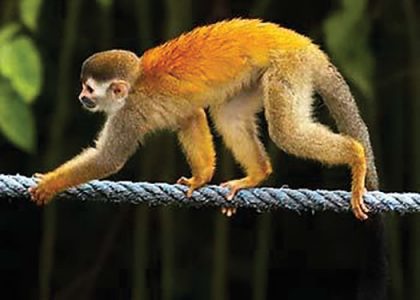
In the year 2000, a group called Amigos Del Monos came to Kids Saving the Rainforest (KSTR) and told us that they could not get ICE, (the Electric Company), to help them put up monkey bridges. They felt that KSTR could get their attention.
Luckily, we could do so and the KSTR Wildlife Bridge Program was started. In the beginning, KSTR had a team to put up the bridges as you can see in a picture of Lenin putting up a bridge in 2002.
Much later ICE started working hand in hand with KSTR. Since then KSTR gives presentations to ICE’s environmental workers from around the country about the bridges. We also taught their workers how to save wildlife up on the electrical wires.
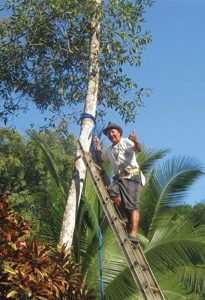
He shimmied up the trees for KSTR!
Many parts of Costa Rica have asked us to teach them how to put up bridges, the latest was this month from south of Manuel Antonio.
In 2016, South American Colombia asked KSTR to teach a delegation about our bridges so that they could copy our work. We asked ICE to participate with us and after giving Columbia presentations the delegation went to see some of the monkey bridges.
To date KSTR has put up over 170 bridges.
Currently there are 130 functioning bridges that we maintain monthly with the help of ICE.
The other bridges have come down because of human encroachment (development).
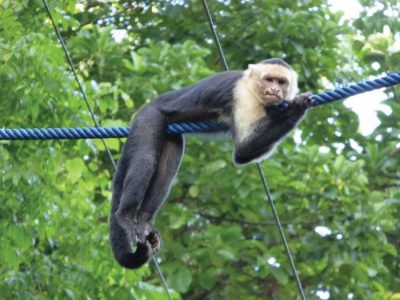
How do we choose where to put the bridges? We put up a bridge wherever wildlife has been electrocuted or hit by a car so that the wildlife can cross busy roads, and to connect with other troops for mating purposes, even when the corridors through which they travel have been fragmented.
With ICE in our monthly monitoring we make sure the branches of trees don’t grow into live wires near bridges.
The rope and clamps for the bridges are very costly and each bridge costs up to $100!
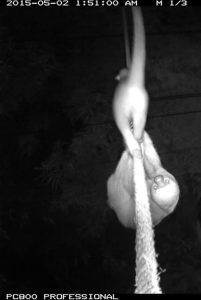
Why do we use blue ropes? Very easy answer, that was the only color that the hardware store had!
KSTR has done studies and surveys of the bridges, including camera traps that have shown over 22 different species crossing the bridges’
At the last official count, there was estimated to be only 1200 of Squirrel (Titi) monkeys left in the world.
Currently our unofficial data by Lenin Roseles states that we now have over 5000 Titi Monkeys!
KSTR is very grateful to have helped make saving this species possible.
The Squirrel monkey had been on the Critically Endangered Red List since 1997 (All this subspecies lives in our area)’
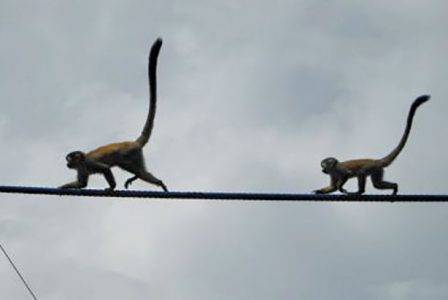
Due to the bridges, reforestation, and conservation, the Squirrel Monkey is no longer on the Critically Endangered Red List.
Janine Licare, one of KSTR’s co-founders, won the 2004 Eco-Hero Award and $500 for KSTR’s Wildlife Bridge Project!
Janine watched a baby sloth die in the arms of KSTR’s Vet, Dr. Pia Martin, because the baby needed oxygen and KSTR couldn’t afford a tank. She immediately used the money to buy an oxygen tank, which is still in use in our clinic today, saving lives.
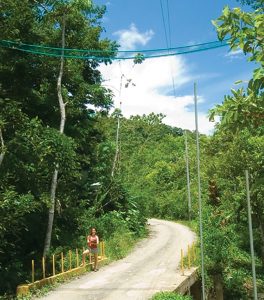
If you want to sponsor a bridge or donate, please contact us at: [email protected] so that you too can save the wildlife in our area.
Thanks so much for reading this! Please contact us if you want more information. You can also take a tour of our Wildlife Sanctuary by writing to [email protected] or calling 4070-0340.
100% of the proceeds go to save the rainforest. So please help us to save the rainforest by taking our tour and learning about the individual stories of how each animal got rescued by KSTR!
Stay tuned next month for Karma Saves the Rainforest, where our new resident spokes kid Karma will tell you all about what’s going on at Kids Saving the Rainforest.
